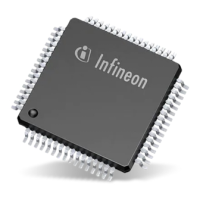Introduction to Digital Power Conversion
XMC4000/1000 Family
Modulation
Application Guide 51 V1.0, 2015-01
6 Modulation
The modulation task is to maintain the steady state duty-cycle-to-output-voltage transfer function of a
sense-modulate-drive control loop in a switch-mode power converter.
Each modulation mode (course of action) meets certain required properties and frequency response
of the converter transfer function.
Modulation Mode
The following are the basic modulation modes, with various steady state duty-cycle-to-output transfer
function properties, and frequency response characteristics, which are often used in combinations to
add performance:
Voltage Control (VC) Error signal feedback High accuracy, lower cost Slow w/ CPU
Average Current Control (ACC) Error signal feedback Mid accuracy, higher cost Slow w/ CPU
Peak Current Control (PCC) Inherent feedback Low accuracy, higher cost Fast w/o CPU
Zero Crossing Detection (ZCD) Inherent feed-back Low accuracy, higher cost Fast w/o CPU
Voltage Control
Voltage Mode Control implies that the actual output voltage deviation from the desired output voltage
(i.e. an error voltage feedback) controls the voltage applied across the inductor.
Advantages
− Low noise sensitivity
− Low cost
− High resolution
− Easy feedback design
Disadvantages
− Slow response to input/output condition changes
− Discontinuous current mode occurrence is out-of-scope
Current Control
Current Mode Control implies that the actual output voltage deviation from the desired output voltage
(i.e. an error voltage feedback) controls the peak current through the inductor.
Advantages
− Fast, single pole response due to removed output capacitor in the feedback
− Responds immediately to input voltage changes
− Inherent cycle-by-cycle current limiting
Disadvantages
− Noise sensitive
− Control stabilization issues at duty-cycles > 50%: Requires slope compensation to reject sub-
oscillations
− Cannot handle too wide input voltage variations
− Difficult to handle low currents
Note: Combined Voltage and Current Mode Control corrects the issues within the respective mode.

